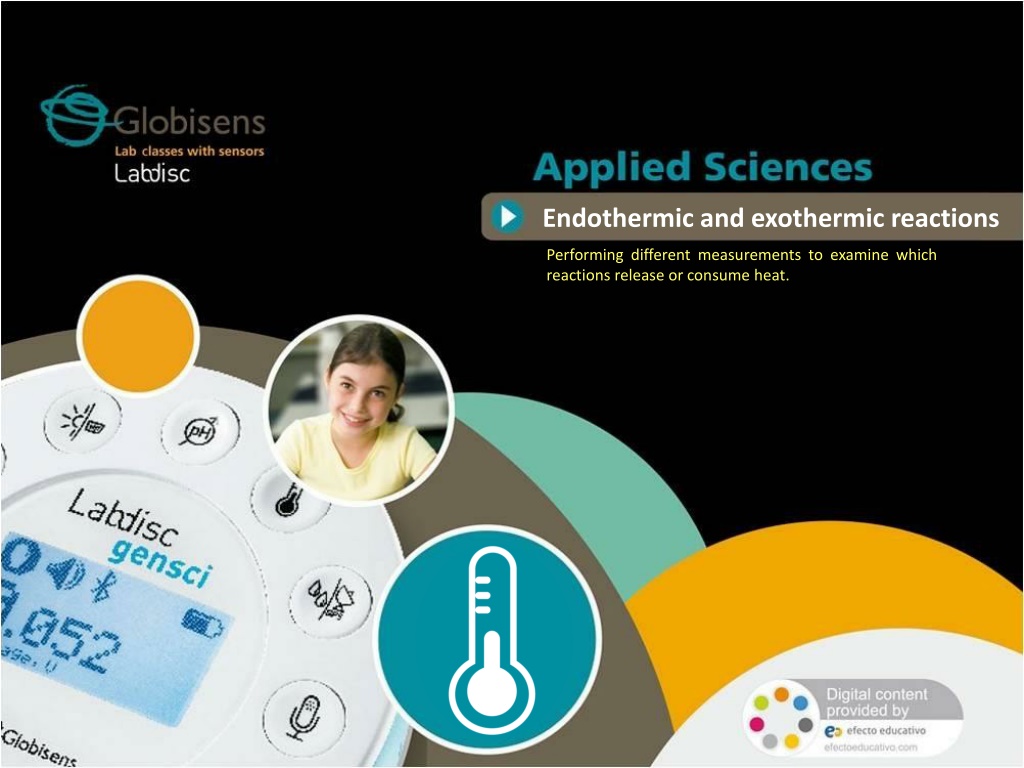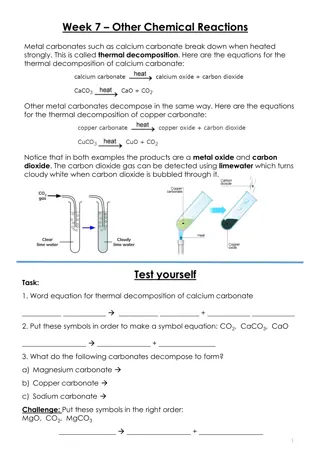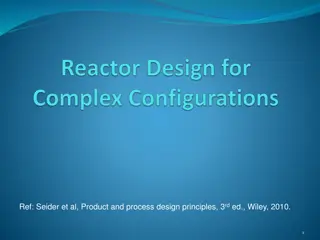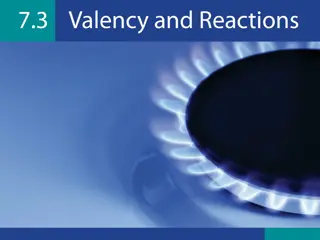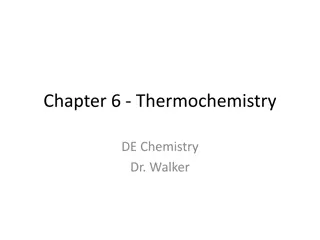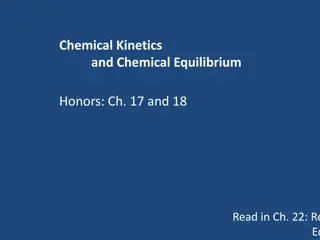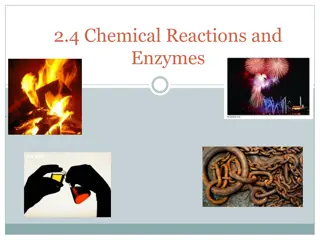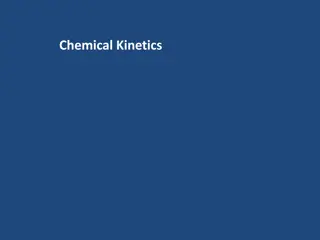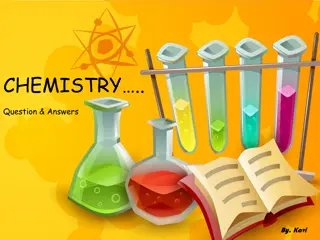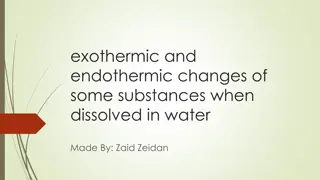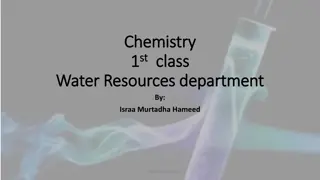Understanding Endothermic and Exothermic Reactions in Chemistry
Exploring endothermic and exothermic reactions, this activity involves measurements to determine heat release or absorption. Students create hypotheses and test them using Labidisc temperature sensors. Theoretical background on chemical reactions, energy absorption, and heat release is provided, enabling students to recognize and differentiate between these types of reactions.
Download Presentation

Please find below an Image/Link to download the presentation.
The content on the website is provided AS IS for your information and personal use only. It may not be sold, licensed, or shared on other websites without obtaining consent from the author. Download presentation by click this link. If you encounter any issues during the download, it is possible that the publisher has removed the file from their server.
E N D
Presentation Transcript
Endothermic and exothermic reactions Performing different measurements to examine which reactions release or consume heat.
Endothermic and exothermic reactions Performing different measurements to examine which reactions release or consume heat. Objective The purpose of this activity is to recognize chemical reactions as endothermic and exothermic. Students will then create a hypothesis and proceed to test it using the Labidisc external temperature sensor.
Endothermic and exothermic reactions Performing different measurements to examine which reactions release or consume heat. Introduction and theory We commonly observe a series of different physical reactions in the environment, such as ice melting, steam condensing to liquid water, the various ways of producing fire or a piece of rusted steel. Biochemical reactions are also present in nature, for example photosynthesis, whereby carbon dioxide is converted into sugars using chemical and light energy to drive this process. Another example is the reaction of cell digestion governed by the metabolism. This process is related to the body s materials synthesis and to other physiological activities: Transport of substances, muscle contraction and maintaining a constant body temperature. What could be a common cause of such physical everyday reactions?
Endothermic and exothermic reactions Performing different measurements to examine which reactions release or consume heat. Introduction and theory Which of the previously mentioned chemical reactions need energy to transform their matter? Which of them release energy? Try to explain. Carry out the experiment activity with your class so that at the end you ll be able to answer the followingquestion: Do chemical reactions release or absorb energy into or from the environment?
Endothermic and exothermic reactions Performing different measurements to examine which reactions release or consume heat. Introduction and theory Theoretical Chemical reactions need or release energy, generally heat energy. This is the reason why we define reactions as endothermic or word endothermic describes a process in which the system absorbs heat. Therefore, the products of higher energy levels than the reactants and its surroundings get colder. In contrast, processes are characterized by lower energy products than reactants, with temperature increases environment. exothermic. The reaction creates exothermic in the
Endothermic and exothermic reactions Performing different measurements to examine which reactions release or consume heat. Introduction and theory Now students are encouraged to raise a hypothesis which must be tested with an experiment. If you measure the temperature of both endothermic and exothermic reactions, what results do you expect to find?
Endothermic and exothermic reactions Performing different measurements to examine which reactions release or consume heat. Activity description Students will measure the temperature of two ongoing reactions: (1) Acetic acid (vinegar) / Sodium bicarbonate and (2) Water / hydrochloric acid (HCl), using the Labdisc external temperature probe. They will identify which of them release or absorb heat energy from the environment.
Endothermic and exothermic reactions Performing different measurements to examine which reactions release or consume heat. Resources and materials Labdisc Gensci Temperature probe 2 Polystyrene cups Hydrochloric acid (0.1 M) Acetic acid Sodium bicarbonate Water
Endothermic and exothermic reactions Performing different measurements to examine which reactions release or consume heat. Using the Labdisc Labdisc configuration To collect measurements with the external temperature sensor, the Labdisc must be configured according to the following steps: 1 Open the GlobiLab software and turn on the Labdisc. 2 Click on the Bluetooth icon in the bottom right corner of the GlobiLab screen. Select the Labdisc you are using currently. Once the Labdisc has been recognized by the software, the icon will change from a grey to blue color . If you prefer a USB connection follow the previous instruction clicking on the USB icon. You will see the same color change when the Labdisc is recognized .
Endothermic and exothermic reactions Performing different measurements to examine which reactions release or consume heat. Using the Labdisc 3 Click on Logger Setup window. Enter 1/s for Rate and 1000 for Samples. to configure the Labdisc. Select external temperature in the
Endothermic and exothermic reactions Performing different measurements to examine which reactions release or consume heat. Using the Labdisc 4 Once you have finished the sensor configuration start measuring by clicking . Once you have finished measuring stop the Labdisc by clicking . 5
Endothermic and exothermic reactions Performing different measurements to examine which reactions release or consume heat. Experiment Pour 60 ml of acetic acid into the polystyrene cup and start the temperature measurements. Weigh 3 grams of sodium bicarbonate and add it to the solution. Do not stir the compounds. Observe the temperature variations. Once the temperature is stabilized, stop the Labdisc, take out the temperature probe and dry it.
Endothermic and exothermic reactions Endothermic and exothermic reactions Performing different measurements to examine which reactions release or consume heat. reactions release or consume heat. Performing different measurements to examine which Experiment Experiment Pour 50 ml of water in a new polystyrene cup and make a new temperature recording After that, pour 25 ml of HCl [0,1 M] and observe your measurements on the screen. At the end of the experiment, stop the Labdisc.
Endothermic and exothermic reactions Performing different measurements to examine which reactions release or consume heat. Results and analysis Label parts of the curve according to the experimental stages with the tool. After that, show temperature values from the initial and final states with the markers, by clicking on the curve sections . Maximum and minimum values of temperature can also be observed using the statistics tool from the menu.
Endothermic and exothermic reactions Performing different measurements to examine which reactions release or consume heat. Results and analysis How do the results relate to your initial hypothesis? Explain. What were the temperatures before and after mixing the compounds in each reaction? Did you find comparative differences between reactions? Remember your observations.
Endothermic and exothermic reactions Performing different measurements to examine which reactions release or consume heat. Results and analysis The graph below should be similar to the one the students came up with:
Endothermic and exothermic reactions Endothermic and exothermic reactions Performing different measurements to examine which reactions release or consume heat. reactions release or consume heat. Performing different measurements to examine which Results and analysis Results and analysis The graph below should be similar to the one the students came up with:
Endothermic and exothermic reactions Performing different measurements to examine which reactions release or consume heat. Conclusion What criterion would you use to define the type of reaction in each case? Students should point out based on the theoretical background that the difference between final and initial temperature is enough to determine the type of reaction in each case. Exothermic reactions release energy in form of heat and endothermic reactions absorb heat energy from the environment. Why are the reactions exothermic and endothermic in terms of bond breaking and bond making? Students should deduce that the compounds or reactants interact during the reactions. They have to consider that breaking a chemical bond requires energy and forming a chemical bond will release energy as a net result. In the case of endothermic reaction, vinegar and baking soda are combined to form a new molecular structure which stores the absorbed heat energy from the surroundings. On the other hand, the bond of dissolved HCl is broken first, but the hydrogen ion then reacts with water molecules to form a complex due to the hydration of the hydrogen positive ion.
Endothermic and exothermic reactions Performing different measurements to examine which reactions release or consume heat. Activities for further application How are chemical and kinetic energy related? Perform research to answer. Students should find out that the chemical energy is the potential amount of energy that atoms store when they create bounds to form molecules. If you add chemical energy and kinetic energy (energy of molecular motion), the total internal energy is obtained from the sum of both. If the system is not heated or cooled its internal energy remains constant. Therefore, if you increase chemical energy, kinetic energy decreases and temperature falls. On the other hand, if chemical energy decreases, particles will move faster, and therefore temperature will rise. How could we observe endothermic and exothermic reactions simultaneously? Students should relate chemical reactions to the absorption and release of heat from the environment. They should point out that they could couple two chemical reactions. For example, an exothermic reaction that first releases heat which could then be used to start an endothermic reaction.
